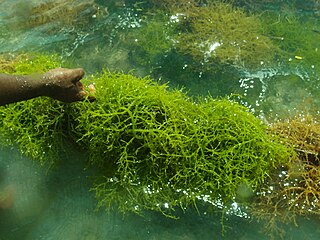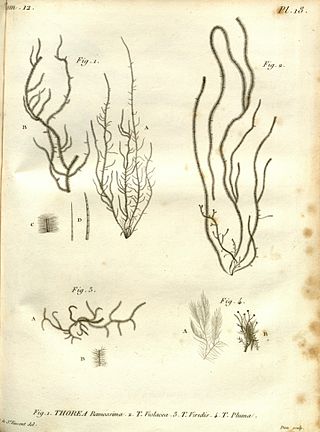
Gracilaria is a genus of red algae (Rhodophyta) notable for its economic importance as an agarophyte, as well as its use as a food for humans and various species of shellfish. Various species within the genus are cultivated among Asia, South America, Africa and Oceania.

The Gelidiaceae is a small family of red algae containing eight genera. Many species of this algae are used to make agar.

The Delesseriaceae is a family of about 100 genera of marine red alga.
The Sporolithaceae is the only known family of algae in the Sporolithales order.

Galaxauraceae is a family of red algae (Rhodophyta) in the order Nemaliales.

Nemaliales is an order of red algae.

Solieriaceae is a family of red algae in the order Gigartinales.

Dumontiaceae is a red alga family in the order Gigartinales.

Hypnea is a genus of red algae, and a well known carrageenophyte.

Furcellaria is a genus of red algae. It is a monotypic genus, the only species being Furcellaria lumbricalis, which has commercial importance as a raw material for carrageenan production. It is mainly harvested from the waters of Denmark and Canada.

Pyropia is a genus of red algae [seaweed] in the family Bangiaceae. It is found around the world in intertidal zones and shallow water. The genus has folding frond-like blades which are either red, brown or green. Some Pyropia species are used to create nori, and are thus important subjects for aquaculture.

The Gelidiellaceae is a small family of red algae containing 5 genera of agarophytes.

The Pterocladiaceae is a small family of red algae containing 2 genera of agarophytes.

The Gracilariaceae is a small family of red algae containing several genera of agarophytes. It has a world-wide distribution. 24 species are found in China, and 6 species are found in Great Britain and Ireland. It is found in Australia and Chile.

Naccariaceae is a family of red algae in the order Bonnemaisoniales, with 3 monotypic genera. Which are found in both the Pacific and Atlantic Oceans.

Wrangelia is a genus of red algae in the family Wrangeliaceae.

Callithamnion is a genus of algae belonging to the family Callithamniaceae.

Liagoraceae is a family of red algae (Rhodophyta) in the order Nemaliales. The type genus is LiagoraJ.V.Lamouroux.

Thoreales is an order of red algae belonging to the class Florideophyceae. The order consists only one family, ThoreaceaeHassall, 1845. The family of Thoreaceae was circumscribed by Arthur Hill Hassall in A history of the British freshwater algae, including descriptions of the Desmideae and Diatomaceae in 1845.

Halymeniales is an order of red algae belonging to the class Florideophyceae and the subclass Rhodymeniophycidae.
















